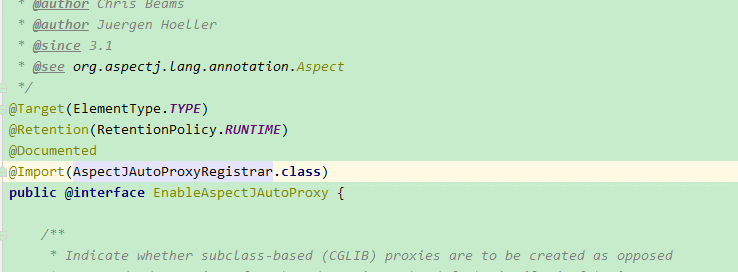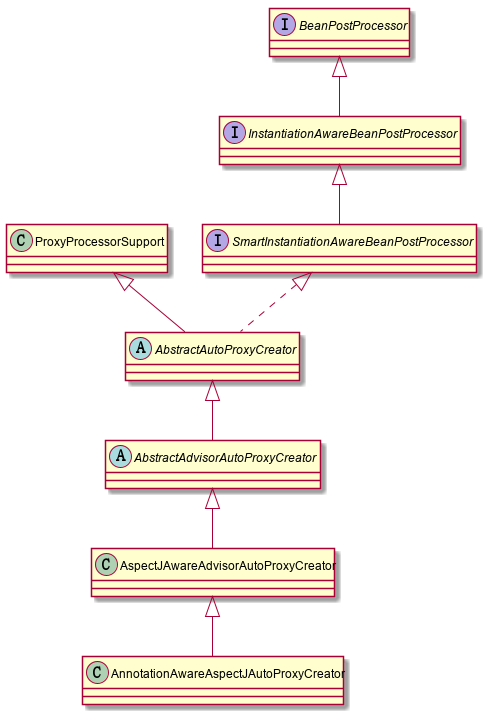Spring如何实现AOP,请不要再说cglib了!
最近工作中我都是基于注解实现AOP功能,常用的开启AOP的注解是@EnableAspectJAutoProxy,我们就从它入手。

上面的动图的流程的步骤就是:
@EnableAspectJAutoProxy
--> AspectJAutoProxyRegistrar
-->AopConfigUtils .registerAspectJAnnotationAutoProxyCreatorIfNecessary
-->AnnotationAwareAspectJAutoProxyCreator.class
AnnotationAwareAspectJAutoProxyCreator查看其中文注释(如下),确定它就是AOP的核心类!--温安适 20191020
/**
1.AspectJAwareAdvisorAutoProxyCreator的子类
,用于处理当前应用上下文中的注解切面
2.任何被AspectJ注解的类将自动被识别。
3.若SpringAOP代理模式可以识别,优先使用Spring代理模式。
4.它覆盖了方法执行连接点
5.如果使用<aop:include>元素,
则只有名称与include模式匹配的@aspectj bean才被视为切面
,并由spring自动代理。
6. Spring Advisors的处理请查阅,
org.springframework.aop
.framework.autoproxy.AbstractAdvisorAutoProxyCreator
*/
@SuppressWarnings("serial")
public class AnnotationAwareAspectJAutoProxyCreator
extends AspectJAwareAdvisorAutoProxyCreator {
//...省略实现
}注解切面
复制代码
虽然找到了核心类,但是并没有找到核心方法!下面我们尝试画类图确定核心方法。
2.画核心类类图,猜测核心方法
AnnotationAwareAspectJAutoProxyCreator的部分类图。

从类图看到了AnnotationAwareAspectJAutoProxyCreator实现了BeanPostProcessor,而AOP功能应该在创建完Bean之后执行,猜测AnnotationAwareAspectJAutoProxyCreator实现BeanPostProcessor的postProcessAfterInitialization(实例化bean后处理)是核心方法。 查看AnnotationAwareAspectJAutoProxyCreator实现的postProcessAfterInitialization方法,实际该方法在其父类AbstractAutoProxyCreator中。
//AbstractAutoProxyCreator中的postProcessAfterInitialization实现
@Override
public Object postProcessAfterInitialization(Object bean, String beanName)
throws BeansException {
if (bean != null) {
Object cacheKey = getCacheKey(bean.getClass(), beanName);
if (!this.earlyProxyReferences.contains(cacheKey)) {
return wrapIfNecessary(bean, beanName, cacheKey);
}
}
return bean;
}
复制代码
发现发现疑似方法wrapIfNecessary,查看其源码如下,发现createProxy方法。确定找对了地方。
protected Object wrapIfNecessary
(Object bean, String beanName, Object cacheKey) {
if (beanName != null && this.targetSourcedBeans.contains(beanName)) {
return bean;
}
if (Boolean.FALSE.equals(this.advisedBeans.get(cacheKey))) {
return bean;
}
if (isInfrastructureClass(bean.getClass())
|| shouldSkip(bean.getClass(), beanName)) {
this.advisedBeans.put(cacheKey, Boolean.FALSE);
return bean;
}
// 创建代理
Object[] specificInterceptors =
getAdvicesAndAdvisorsForBean(bean.getClass(), beanName, null);
if (specificInterceptors != DO_NOT_PROXY) {
this.advisedBeans.put(cacheKey, Boolean.TRUE);
Object proxy = createProxy(
bean.getClass(), beanName,
specificInterceptors, new SingletonTargetSource(bean));
this.proxyTypes.put(cacheKey, proxy.getClass());
return proxy;
}
this.advisedBeans.put(cacheKey, Boolean.FALSE);
return bean;
}
复制代码
即AnnotationAwareAspectJAutoProxyCreator实现BeanPostProcessor的postProcessAfterInitialization方法,在该方法中由wrapIfNecessary实现了AOP的功能。 wrapIfNecessary中有2个和核心方法
- getAdvicesAndAdvisorsForBean获取当前bean匹配的增强器
- createProxy为当前bean创建代理
要想明白核心流程还需要分析这2个方法。
3.读重点方法,理核心流程
3.1 getAdvicesAndAdvisorsForBean获取当前bean匹配的增强器
查看源码如下,默认实现在AbstractAdvisorAutoProxyCreator中。
@Override
@Nullable
protected Object[] getAdvicesAndAdvisorsForBean(
Class<?> beanClass, String beanName,
@Nullable TargetSource targetSource) {
List<Advisor> advisors = findEligibleAdvisors(beanClass, beanName);
if (advisors.isEmpty()) {
return DO_NOT_PROXY;
}
return advisors.toArray();
}
复制代码
查阅findEligibleAdvisors方法,就干了3件事
- 找所有增强器,也就是所有@Aspect注解的Bean
- 找匹配的增强器,也就是根据 @Before ,@After等注解上的表达式,与当前bean进行匹配,暴露匹配上的。
- 对匹配的增强器进行扩展和排序,就是按照@Order或者PriorityOrdered的getOrder的数据值进行排序,越小的越靠前。
protected List<Advisor> findEligibleAdvisors(Class<?> beanClass, String beanName) {
//找所有增强器
List<Advisor> candidateAdvisors = findCandidateAdvisors();
//找所有匹配的增强器
List<Advisor> eligibleAdvisors = findAdvisorsThatCanApply(candidateAdvisors, beanClass, beanName);
extendAdvisors(eligibleAdvisors);
if (!eligibleAdvisors.isEmpty()) {
//排序
eligibleAdvisors = sortAdvisors(eligibleAdvisors);
}
return eligibleAdvisors;
}
复制代码
AnnotationAwareAspectJAutoProxyCreator 重写了findCandidateAdvisors,下面我们看看具体实现了什么
3.1.1findCandidateAdvisors找所有增强器,也就是所有@Aspect注解的Bean
@Override
protected List<Advisor> findCandidateAdvisors() {
// Add all the Spring advisors found according to superclass rules.
List<Advisor> advisors = super.findCandidateAdvisors();
// Build Advisors for all AspectJ aspects in the bean factory.
if (this.aspectJAdvisorsBuilder != null) {
//@Aspect注解的类在这里除了
advisors.addAll(this.aspectJAdvisorsBuilder.buildAspectJAdvisors());
}
return advisors;
}
复制代码
从该方法我们可以看到 处理@Aspect注解的bean的方法是:this.aspectJAdvisorsBuilder.buildAspectJAdvisors() 。 这个方法如下:
public List<Advisor> buildAspectJAdvisors() {
List<String> aspectNames = this.aspectBeanNames;
if (aspectNames == null) {
synchronized (this) {
aspectNames = this.aspectBeanNames;
if (aspectNames == null) {
List<Advisor> advisors = new ArrayList<>();
aspectNames = new ArrayList<>();
//找到所有BeanName
String[] beanNames = BeanFactoryUtils.beanNamesForTypeIncludingAncestors(
this.beanFactory, Object.class, true, false);
for (String beanName : beanNames) {
if (!isEligibleBean(beanName)) {
continue;
}
// 必须注意,bean会提前暴露,并被Spring容器缓存,但是这时还不能织入。
Class<?> beanType = this.beanFactory.getType(beanName);
if (beanType == null) {
continue;
}
if (this.advisorFactory.isAspect(beanType)) {
//找到所有被@Aspect注解的类
aspectNames.add(beanName);
AspectMetadata amd = new AspectMetadata(beanType, beanName);
if (amd.getAjType().getPerClause().getKind() == PerClauseKind.SINGLETON) {
MetadataAwareAspectInstanceFactory factory =
new BeanFactoryAspectInstanceFactory(this.beanFactory, beanName);
//解析封装为Advisor返回
List<Advisor> classAdvisors = this.advisorFactory.getAdvisors(factory);
if (this.beanFactory.isSingleton(beanName)) {
this.advisorsCache.put(beanName, classAdvisors);
}
else {
this.aspectFactoryCache.put(beanName, factory);
}
advisors.addAll(classAdvisors);
}
else {
// Per target or per this.
if (this.beanFactory.isSingleton(beanName)) {
throw new IllegalArgumentException("Bean with name '" + beanName +
"' is a singleton, but aspect instantiation model is not singleton");
}
MetadataAwareAspectInstanceFactory factory =
new PrototypeAspectInstanceFactory(this.beanFactory, beanName);
this.aspectFactoryCache.put(beanName, factory);
advisors.addAll(this.advisorFactory.getAdvisors(factory));
}
}
}
this.aspectBeanNames = aspectNames;
return advisors;
}
}
}
if (aspectNames.isEmpty()) {
return Collections.emptyList();
}
List<Advisor> advisors = new ArrayList<>();
for (String aspectName : aspectNames) {
List<Advisor> cachedAdvisors = this.advisorsCache.get(aspectName);
if (cachedAdvisors != null) {
advisors.addAll(cachedAdvisors);
}
else {
MetadataAwareAspectInstanceFactory factory = this.aspectFactoryCache.get(aspectName);
advisors.addAll(this.advisorFactory.getAdvisors(factory));
}
}
return advisors;
}
复制代码
这个方法可以概括为:
- 找到所有BeanName
- 根据BeanName筛选出被@Aspect注解的类
- 针对类中被Around.class, Before.class, After.class, AfterReturning.class, AfterThrowing.class注解的方法,先按上边的注解顺序排序后按方法名称排序,每一个方法对应一个Advisor。
3.2 createProxy为当前bean创建代理。
3.2.1 创建代理的2种方式
众所周知,创建代理的常用的2种方式是:JDK创建和CGLIB,下面我们就看看这2中创建代理的例子。
3.2.1 .1 jdk创建代理的例子
import java.lang.reflect.InvocationHandler;
import java.lang.reflect.Method;
import java.lang.reflect.Proxy;
public class JDKProxyMain {
public static void main(String[] args) {
JDKProxyTestInterface target = new JDKProxyTestInterfaceImpl();
// 根据目标对象创建代理对象
JDKProxyTestInterface proxy =
(JDKProxyTestInterface) Proxy
.newProxyInstance(target.getClass().getClassLoader(),
target.getClass().getInterfaces(),
new JDKProxyTestInvocationHandler(target));
// 调用代理对象方法
proxy.testProxy();
}
interface JDKProxyTestInterface {
void testProxy();
}
static class JDKProxyTestInterfaceImpl
implements JDKProxyTestInterface {
@Override
public void testProxy() {
System.out.println("testProxy");
}
}
static class JDKProxyTestInvocationHandler
implements InvocationHandler {
private Object target;
public JDKProxyTestInvocationHandler(Object target){
this.target=target;
}
@Override
public Object invoke(Object proxy, Method method,
Object[] args) throws Throwable {
System.out.println("执行前");
Object result= method.invoke(this.target,args);
System.out.println("执行后");
return result;
}
}
复制代码
3.2.1 .2 cglib创建代理的例子
import org.springframework.cglib.proxy.Enhancer;
import org.springframework.cglib.proxy.MethodInterceptor;
import org.springframework.cglib.proxy.MethodProxy;
import java.lang.reflect.Method;
public class CglibProxyTest {
static class CglibProxyService {
public CglibProxyService(){
}
void sayHello(){
System.out.println(" hello !");
}
}
static class CglibProxyInterceptor implements MethodInterceptor{
@Override
public Object intercept(Object sub, Method method,
Object[] objects, MethodProxy methodProxy)
throws Throwable {
System.out.println("before hello");
Object object = methodProxy.invokeSuper(sub, objects);
System.out.println("after hello");
return object;
}
}
public static void main(String[] args) {
// 通过CGLIB动态代理获取代理对象的过程
Enhancer enhancer = new Enhancer();
// 设置enhancer对象的父类
enhancer.setSuperclass(CglibProxyService.class);
// 设置enhancer的回调对象
enhancer.setCallback(new CglibProxyInterceptor());
// 创建代理对象
CglibProxyService proxy= (CglibProxyService)enhancer.create();
System.out.println(CglibProxyService.class);
System.out.println(proxy.getClass());
// 通过代理对象调用目标方法
proxy.sayHello();
}
}
复制代码
3.2.1 .3 jdk创建代理与cglib创建代理的区别
| 类型 | jdk创建动态代理 | cglib创建动态代理 |
|---|---|---|
| 原理 | java动态代理是利用反射机制生成一个实现代理接口的匿名类,在调用具体方法前调用InvokeHandler来处理 | cglib动态代理是利用asm开源包,对代理对象类的class文件加载进来,通过修改其字节码生成子类来处理 |
| 核心类 | Proxy 创建代理利用反射机制生成一个实现代理接口的匿名类InvocationHandler 方法拦截器接口,需要实现invoke方法 | net.sf.cglib.proxy.Enhancer:主要增强类,通过字节码技术动态创建委托类的子类实例net.sf.cglib.proxy.MethodInterceptor:方法拦截器接口,需要实现intercept方法 |
| 局限性 | 只能代理实现了接口的类 | 不能对final修饰的类进行代理,也不能处理final修饰的方法 |
3.2.2 Spring如何选择的使用哪种方式
Spring的选择选择如何代理时在DefaultAopProxyFactory 中。
public class DefaultAopProxyFactory implements AopProxyFactory,
Serializable {
@Override
public AopProxy createAopProxy(AdvisedSupport config)
throws AopConfigException {
if (config.isOptimize()
|| config.isProxyTargetClass()
|| hasNoUserSuppliedProxyInterfaces(config)) {
Class<?> targetClass = config.getTargetClass();
if (targetClass == null) {
throw new AopConfigException(
"TargetSource cannot determine target class: "
+"Either an interface or a target "+
" is required for proxy creation.");
}
if (targetClass.isInterface()
|| Proxy.isProxyClass(targetClass)) {
return new JdkDynamicAopProxy(config);
}
return new ObjenesisCglibAopProxy(config);
}
else {
return new JdkDynamicAopProxy(config);
}
}
//...
}
复制代码
- config.isOptimize() 查看源码注释时发现,这个是配置使用cglib代理时,是否使用积极策略。这个值一般不建议使用!
- config.isProxyTargetClass() 就是@EnableAspectJAutoProxy中的proxyTargetClass属性。
//exposeProxy=true AopContext 可以访问,proxyTargetClass=true CGLIB生成代理 @EnableAspectJAutoProxy(exposeProxy=true,proxyTargetClass=true)
- hasNoUserSuppliedProxyInterfaces 是否存在可代理的接口
总结下Spring如何选择创建代理的方式:
- 如果设置了proxyTargetClass=true,一定是CGLIB代理
- 如果proxyTargetClass=false,目标对象实现了接口,走JDK代理
- 如果没有实现接口,走CGLIB代理
- 本文标签: ip IO 数据 Proxy Collections java http tar ArrayList 注释 类图 总结 db cache UI newProxyInstance 实例 spring src id 代码 zab final tab bean 配置 synchronized 解析 rmi lib https AOP API 缓存 list 源码 Service cat 字节码 App 2019 build struct Collection IDE cglib key ssl ACE find equals CTO tk 开源
- 版权声明: 本文为互联网转载文章,出处已在文章中说明(部分除外)。如果侵权,请联系本站长删除,谢谢。
- 本文海报: 生成海报一 生成海报二











![[HBLOG]公众号](https://www.liuhaihua.cn/img/qrcode_gzh.jpg)

